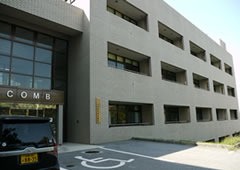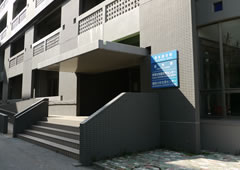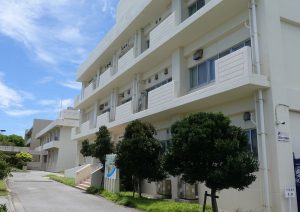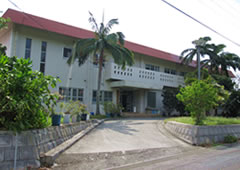PURPOSES OF THE FOUNDATION
The Tropical Biosphere Research Center (TBRC) is a research institute of University of the Ryukyus located in subtropical climate zone. Faculty members of TBRC are conducting biological researches on the tropical and subtropical environment. The researches are mainly focused on the mechanism of establishment and maintenance of biological diversity, the survival strategies of living organisms, and the dynamic interactions of symbiotic or infectious microbes with hosts. Applied researches on food and health in subtropical area is also carried out in TBRC. These research activities covers all four Key Words of the University of the Ryukyus: Islands, Marine, Subtropical Climate, and Health and Longevity.
TBRC has been approved to be a Joint Usage/Research Center (JURC) by the Ministry of Education, Culture, Sports, Science and Technology (MEXT) of Japan. As the only JURC in the subtropical climate zone, TBRC provides opportunities to study subtropical organisms and ecosystems for both domestic and international researchers. TBRC has great access to resources of the insular environments of the Ryukyu Archipelago with high endemism that have been developed in humid subtropical climate under complex geographical history, which includes coral reefs and mangrove forests with high biodiversity. Iriomote and Sesoko Stations of TBRC are located right next to coral reefs and mangrove forests, respectively, and are equipped with dormitories and laboratories available for the field researchers.
Establishment of interdisciplinary research area of field research and molecular biology is another important goal of TBRC. Center of Molecular Biosciences (COMB) and Nishihara Station of TBRC in Senbaru Campus are important role in the issue. At present, genome sequencing of tropical field-derived samples becomes standard analyses in recent years. To further improve co-operation between the Stations, teleconference system is active used to exchange of information.
2021 is an important year cerebrating 50-year Anniversary of TBRC. In 1971, Sesoko station was established as Marine Science Laboratory of Faculty of Science and Enginering, and Iriomote Stations was established as Research institute of Tropical Agriculture of Faculty of Agricultre.
It is a good timing to review our previous research activity and establish the basis of research activity for coming 50 years. TBRC continues to be a biological research center of University of the Ryukyus, and will reinforce the function as JURC.
History
Tropical Biosphere Research Center
The Tropical Biosphere Research Center of the University of the Ryukyus was established by unifying a cooperative institute Sesoko Marine Science Center in Sesoko Island (current Sesoko Station, established in 1971), Research Institute of Tropical Agriculture of Faculty of Agriculture in Iriomote Island (current Iriomote Station, established in 1971) and newly established Nishihara Laboratory in Senbaru Campus (current Nishihara Station), and assigned as a Joint-use Research Institute in 1994.
Center of Molecular Biosciences
The Center of Molecular Biosciences (COMB) was established in 2001 by reorganization of the Gene Research Center. COMB had been situated in the main campus of the University of the Ryukyus and had been a central research institute of molecular biosciences in the university.
The former Tropical Biosphere Research Center and the Center of Molecular Biosciences are unified in 2009 to launch the new Tropical Biosphere Research Center, and it was certified as a Joint Usage/Research Center by the Minister of Education, Culture, Sports, Science and Technology (MEXT) of Japan in 2010.
ORGANIZATION AND MANAGEMENT
- Director
- Vice Director
- Advisory Committee
- Council
- Department of Coral Reef Biological Science
- Department of Biodiversity and Evolutionary Biology
- Department of Infectious Diseases
- Department of Applied Biological Information
- Marine and terrestrial field ecology Group
- Department of Cooperative Biosphere Research
- Department of Technical Assistance
- General Strategic
Planning Division Research Promotion
Section
ORGANIZATION OF FACITITIES
The Tropical Biosphere Research Center of University of the Ryukyus, consisted of four institutes:
Sesoko Station located in Sesoko Island, an islet off the northern part of the Main Island of Okinawa, Center of Molecular Biosciences and Nishihara Station in the main campus of the university which is located in the southern part of the Main Island of Okinawa, and Iriomote Station located in Iriomote Island, approximately 430 km southwest of the Main Island of Okinawa.
-

Center of Molecular Biosciences(COMB)
RESEARCH AND EDUCATION
Distinctive features
The salient feature of the Tropical Biosphere Research Center (TBRC) lies in its geographic location, which permits long-term in-situ studies on a tropical biota. TBRC is, therefore, expected to play a central role in biological research of tropical and subtropical subjects in Japan. Many foreign and domestic researchers visit TBRC, and create fascinating opportunities to enjoy stimulating and constructive discussion. The geographic advantage is also beneficial to students in both education and research by providing an “in-situ lecturing” with actual organisms in their natural habitats.
TBRC was designated from 1996-2000 as a Center of Collaboration by the corresponding ministry and received additional funding for several research-supporting programs. In 2008, TBRC was combined with Center of Molecular Biosciences (COMB), and the research area has been extended to include genomics, biotechnology, bioremediation, and molecular microbiology with increase in the number of staff members. At the same time, TBRC was approved to be a Joint Usage/Research Center (JURC) by Ministry of Education, Culture, Sports, Science and Technology (MEXT) of Japan. Furthermore, the Foreign Scholar Invitation Program provides a good opportunity to promote international co-operative research, and the Domestic Scholar Invitation Program is helpful in expanding research activities.
Cooperative studies
Cooperate Study Program financially supports researchers who collaborate with TBRC faculty members, or those who use the field of TBRC with support of TBRC faculty members.
Cooperative workshops
Cooperative Workshop Program financially supports symposiums and meetings on tropical and subtropical biospheres to promote future cooperative researches.
Education
TBRC faculty members are actively engaged in lectures and mentorship of master’s or Ph.D. students for graduate schools (Engineering and Science, Agriculture and Medicine). We also offer lectures, practical courses (e.g. Marine Biology Course) and other activities for undergraduate education.
Publications
TBRC publishes Annual Reports, and information on the research activity including the Annual Reports is uploaded to the website of TBRC.
Accommodation
Dormitories are available at Sesoko Station and Iriomote Station. The facilities are available for visitors who participate in researches meetings and practical courses.
令和5年度 熱帯生物圏研究センター併任教員一覧
| 氏名 | 所属・職名 | 研究課題 | センター受入教員 | 受入部門・分野 | 備考 |
|---|---|---|---|---|---|
| 竹村 明洋 | 理学部海洋自然科学科生物系・教授 | サンゴ礁生物の環境利用特性に関する研究 | 守田 昌哉 | サンゴ礁生物科学部門・サンゴ礁生物機能学分野 | 継続 |
| Reimer, James Davis | 理学部海洋自然科学科生物系・教授 | サンゴ礁域における生物多様性研究 | 成瀬 貫 | サンゴ礁生物科学部門・サンゴ礁生物生態分類学分野 | 継続 |
| 栗原 晴子 | 理学部海洋自然科学科生物系・教授 | 気候変動によるサンゴ礁生態系への影響評価 | 波利井 佐紀 | サンゴ礁生物科学部門・サンゴ礁生物生態分類学分野 | 継続 |
| 久保田 康裕 | 理学部海洋自然科学科生物系・教授 | 亜熱帯島嶼の生物多様性パターンの解明と保全に関する研究 | 徳田 岳 | 陸海フィールド生態学分野(センター長直属) | 継続 |
| 木村 亮介 | 大学院医学研究科医学専攻・教授 | メダカ科魚類をモデルとした熱帯生物圏の多様性に関するゲノミクス研究 | 山平 寿智 | 島嶼多様性生物学部門・多様性生物学分野 | 継続 |
| 金野 俊洋 | 農学部亜熱帯農林環境科学科・准教授 | 熱帯地域の育種に資する基盤研究としての生殖機構の細胞生物学 | 松﨑 吾朗 | 感染生物学部門・分子感染防御学分野 | 継続 |
| 佐藤 行人 | 医学部附属実験実習機器センター 講師 | 環境DNAを用いたマングローブ生態系の生物多様性解析 | 梶田 忠 | サンゴ礁生物科学部門・マングローブ学分野 | 継続 |
| 稲福 征志 | 農学部亜熱帯生物資源科学科・准教授 | 亜熱帯生物資源の新奇機能性の発掘と作用機序の解明、ならびにその高度利用に資する研究 | 岩崎 公典 | 応用生命情報学部門・遺伝資源応用学分野 | 継続 |
| 藤田 和彦 | 理学部物質地球科学科地学系・教授 | サンゴ礁石灰化生物の生理生態及び地球環境変動への応答に関する研究 | 高橋 俊一 | サンゴ礁生物科学部門・サンゴ礁生物生態分類学分野 | 継続 |
| 中村 崇 | 理学部海洋自然科学科生物系・准教授 | 造礁サンゴおよび周辺生物によるミクロ礁景観の形成 | 高橋 俊一 | サンゴ礁生物科学部門・サンゴ礁生物生態分類学分野 | 継続 |









